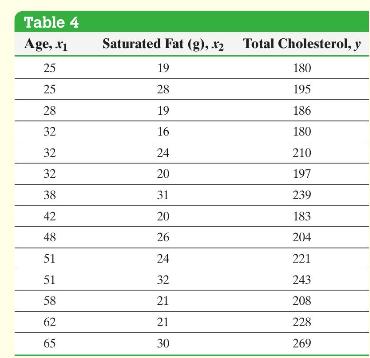For the model obtained in Example 2, determine the coefficient of determination and the adjusted (R^{2}). Compare
Question:
For the model obtained in Example 2, determine the coefficient of determination and the adjusted \(R^{2}\). Compare the \(R^{2}\) with the two explanatory variables age and daily saturated fat to the \(R^{2}\) with the single explanatory variable age. Comment on the effect the additional explanatory variable has on the value of the model.
Approach Use Minitab to determine the values of the coefficient of determination and the adjusted coefficient of determination.
Data from Example 2
Use the data in Table 4.
Find the least-squares regression equation \(\hat{y}=b_{0}+b_{1} x_{1}+b_{2} x_{2}\), where \(x_{1}\) represents the patient's age, \(x_{2}\) represents the patient's daily consumption of saturated fat, and \(y\) represents the patient's total cholesterol.
Draw residual plots and a boxplot of the residuals to assess the adequacy of the model.
Enter the data into Minitab to obtain the least-squares regression equation and to draw the residual plots and boxplot of the residuals. The steps for determining the multiple regression equation and residual plots using Minitab, Excel, and StatCrunch are given in the Technology Step-by-Step.

Step by Step Answer:

Statistics Informed Decisions Using Data
ISBN: 9781292157115
5th Global Edition
Authors: Michael Sullivan





